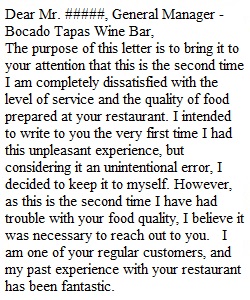


Q Writing Effectively Assignment: Business Letter and Professional Email Purpose: In addition to reports, business-type writing (or rather, professional writing) also encompasses professional emails and business letters. While not all letters are mailed via “snail mail,” some are, but most are attached to professional emails. Some sample business letters include: acceptance letters, rejection letter, job duties letter, etc. However, sometimes a letter must be composed in to alert an organization of an issue, i.e., a complaint letter. For this assignment, you will be composing a complaint letter, as well as a professional email. Part One: Complaint Letter: You will write a business complaint letter to a particular person at a particular organization/business, in order to explain your dissatisfaction with a particular product or service. All of the details (product/service, organization/business, and circumstance) are up to you. The only constants are: you must locate the specific contact person to which your letter should be sent. Required Complaint Letter Components For your complaint letter, you are required to write to the actual (real) contact person of your chosen organization/business (also real). Your goal is to demonstrate your dissatisfaction with a particular product or service, explain the situation, and request an action. Think, also, in terms of TRAJECTORY! ? You can actually send in your complaint letter (via social media, email, or snail mail), and possibly receive some sort of recognition or compensation. **Note: You do not necessarily have to write to a large, corporate, mega, famous organization…it can be a local/smaller business as well.* A business letter requires information before the body of the letter, this includes the following: the sender’s address, the date, and the recipient’s) address. Then, you will compose your letter to the selected person by including in the body of your letter, the following: • Greeting and Address: Dear (title) Mr./Mrs./Dr./Professor/ First Name and Last Name • Introductory paragraph: Explain to the person why you are writing to him/her. Be clear, concise, and specific. [What are your goals/intentions for writing to this person?] • A demonstration of your ethos by explaining the following: how familiar you are with the organization/business, for how long, and how familiar you were or were not with the product/service. Note: you do not have to state: “my ethos is…” You will DEMONSTRATE your ethos through your professionalism and awareness of the organization/business and your familiarity with it. • An explanation of why you are / were dissatisfied with a particular product or service. Set up the scenario: explain what happened, when, how, and why (best guess, if need be). Be sure to give the name of the product or service and the specific date (and time, if possible). Detail is key for this paragraph: paint a picture for the reader. • You will also need to explain how you felt, i.e., why you are / were disappointed. The above paragraph explains what happened; this one shows how you felt and why. Remember: pathos is key, here. Consider: why you were so disappointed with the product? What was the hopeful intended outcome with purchasing said product or service? How did you feel when it was faulty or failed, or did not meet expectation(s)? How does this affect, if at all, your view of the organization/business? Will you continue to purchase from them? Why or why not? • Lastly, you must take the time to explain to the identified person why you took the time to write to him/her. What do you have to gain by bringing this issue to his/her attention? What outcome are you looking for? Compensation? Recognition? Refund? Free items? Etc. **Keep in mind that each chunk of information will be in separate sections, single-spaced (double-spaced between blocks of text), left-justified, in Times New Roman or Arial, 12-pt. font.** Also, check your punctuation, grammar, spelling, run-ons/fragments, etc. Example: [Sender’s Name and Address] [Date] [Recipient’s Name and Address] Dear [Recipient Name—always use their full name and title]: Begin with a statement of purpose: The purpose of this letter is ______. Elaborate on your purpose. Tie up any lose ends such as next expected actions and/or how your reader can follow up. Sincerely, [Your Name and contact information] Part Two: Professional Email to the Contact Create an email for the contact to which you “would” send your letter as an attachment. In your message, be sure to use the professional email template, see below, and let the contact know that your letter is attached. That is the only goal of the professional email for this assignment: let the recipient know that your letter is attached. Note: You are not sending the actual email. You will create your professional email using the professional email template and upload it into the submission link, along with your complaint letter. Professional Email Template **Make sure you have a subject that is relevant to the content within the email. DO NOT leave this section blank!* It is best practice to use 2-5 words for your subject line. 1.) Greeting and Address: i.e., Good afternoon, Mr. Smith. OR, Dear Dr. Williams, • Use the person’s full name and include titles of Mr./Mrs./Ms./ Dr./Detective/Lieutenant, etc. 2.) Introduction sentence: State your purpose for writing the email. 3.) Main Message: This is the actual message of your email: be detailed and specific. Also, be clear with your message: • This means no shorthand • Check for punctuation and spelling, as well as run-ons. • Check the obvious: make sure that you are clear with your message and its intent. • Watch your tone. Be formal. 4.) Sign-Off Sentence: i.e., “I am looking forward to your reply.” OR, “Thank you for your time and consideration.” 5.) Sign Off: Close your e-mail with a “Thank You,” “Sincerely,” “Kind regards,” “Best wishes,” or “Best.” 6.) Signature: Type out your full name (first and last). Note: Sample business letters and sample professional emails can be found in the “Document Samples” folder in Module One.
View Related Questions